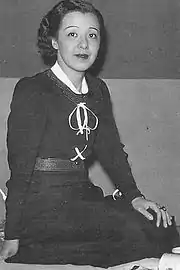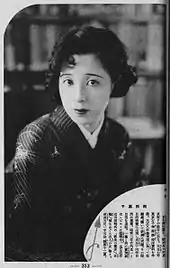Yoshiko Okada
Yoshiko Okada (岡田嘉子, Okada Yoshiko, 21 April 1902 – 10 February 1992) was a Japanese stage and film actress who defected to the Soviet Union in the 1930s.
Yoshiko Okada | |
|---|---|
 Yoshiko Okada circa 1935 | |
| Born | April 21, 1902 |
| Died | February 10, 1992 (aged 89) Moscow, Rusia |
| Nationality | Japanese |
| Occupation | Actress |
Life

Yoshiko Okada was born in Hiroshima Prefecture in 1902. She made her film debut in 1923 at Nikkatsu studios in Eizō Tanaka's Dokuro no mai.[1] She later moved to the Shochiku studios, where she appeared in several films between 1932 and 1937.[2]
On 3 January 1938, Okada defected to the Soviet Union with her lover, theatre director and Communist Party member Ryōkichi Sugimoto,[3] seeking freedom from the militaristic regime of Imperial Japan and hoping to study theatre with other Japanese in the USSR.[4] Sugimoto, however, was arrested and executed as a spy, and Okada spent the next ten years in a prison camp.[3]
At the end of her confinement, Okada began to work for Radio Moscow and eventually got to study at the Lunacharsky State Institute for Theatre Arts. She helped stage a play and was selected to co-direct the film Ten Thousand Boys with Boris Buneev, a work that has been called "the first Russian film about Japan not intended to be a depiction of the 'vicious Japanese enemy.'"[3]
She returned to Japan in 1972, where she appeared on stage, television and in films, but settled down in the Soviet Union again in 1986, where she died in 1992.[1]
Selected filmography
- 1932: No Blood Relation – dir. Mikio Naruse
- 1933: Woman of Tokyo – dir. Yasujirō Ozu
- 1934: Our Neighbor, Miss Yae – Yasujirō Shimazu
- 1935: An Inn in Tokyo – dir. Yasujirō Ozu
- 1976: Tora-san's Sunrise and Sunset – dir. Yoji Yamada
References
- "岡田嘉子 (Yoshiko Okada)" (in Japanese). Kotobank. Retrieved 22 February 2021.
- "岡田嘉子 (Yoshiko Okada)". Japanese Movie Database (in Japanese). Retrieved 22 February 2021.
- Melnikova, Irina (2002). "Representation of Soviet-Japanese Encounters in Co-production Feature Films Part 1. The Musical Harmony" (PDF). Doshisha Studies in Language and Culture. 5 (1): 51–74. Retrieved 22 February 2021.
- Kato, Tetsuro (2000). "The Japanese Victims of Stalinist Terror in the USSR" (PDF). Hitotsubashi Journal of Social Studies. 32 (1): 1–13. Retrieved 22 February 2021.
External links
- Yoshiko Okada at IMDb
- Yoshiko Okada at the Japanese Movie Database (in Japanese)
- "岡田嘉子 (Yoshiko Okada)". Kinenote (in Japanese). Retrieved 22 February 2021.